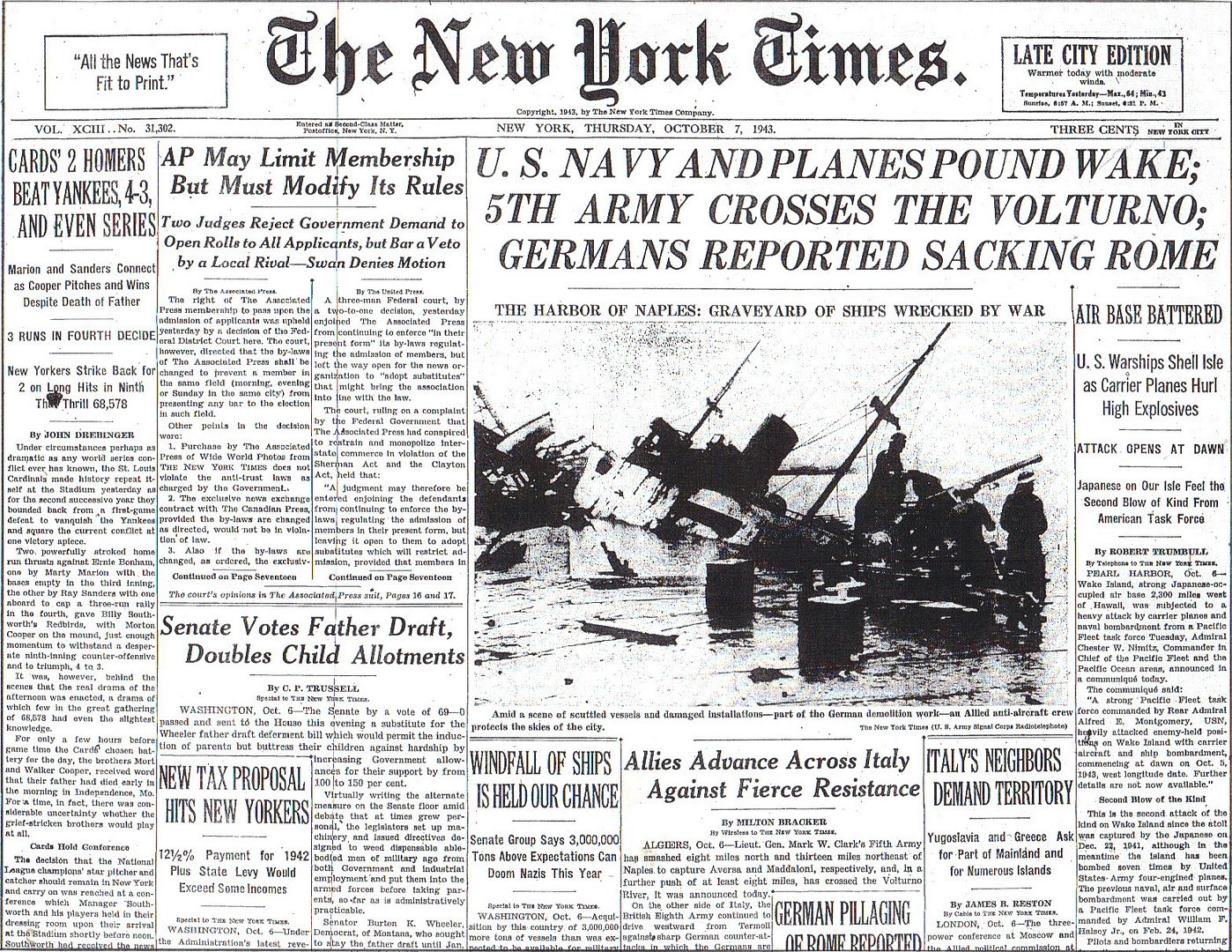
Posted on 10/07/2013 4:14:19 AM PDT by Homer_J_Simpson

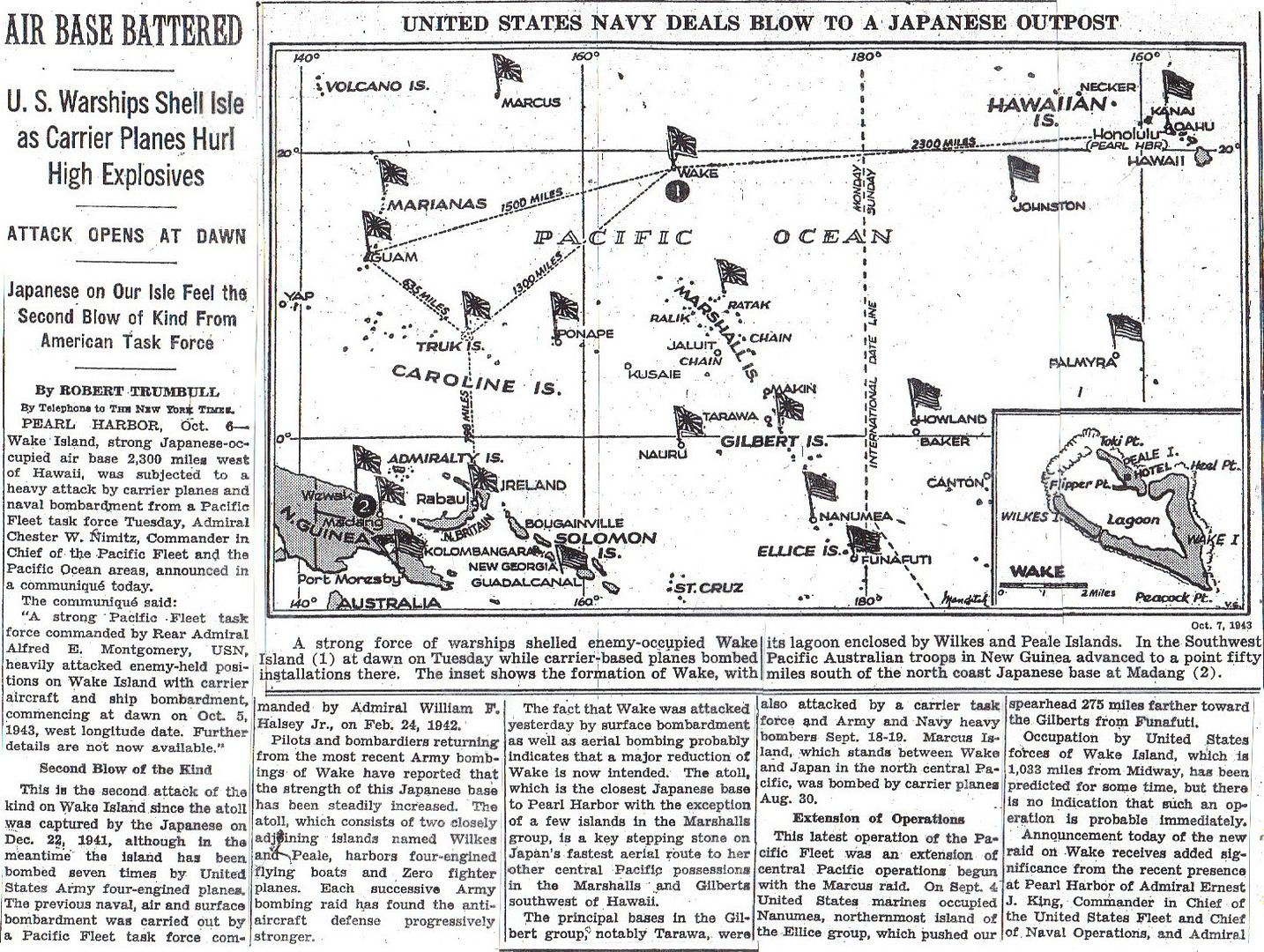
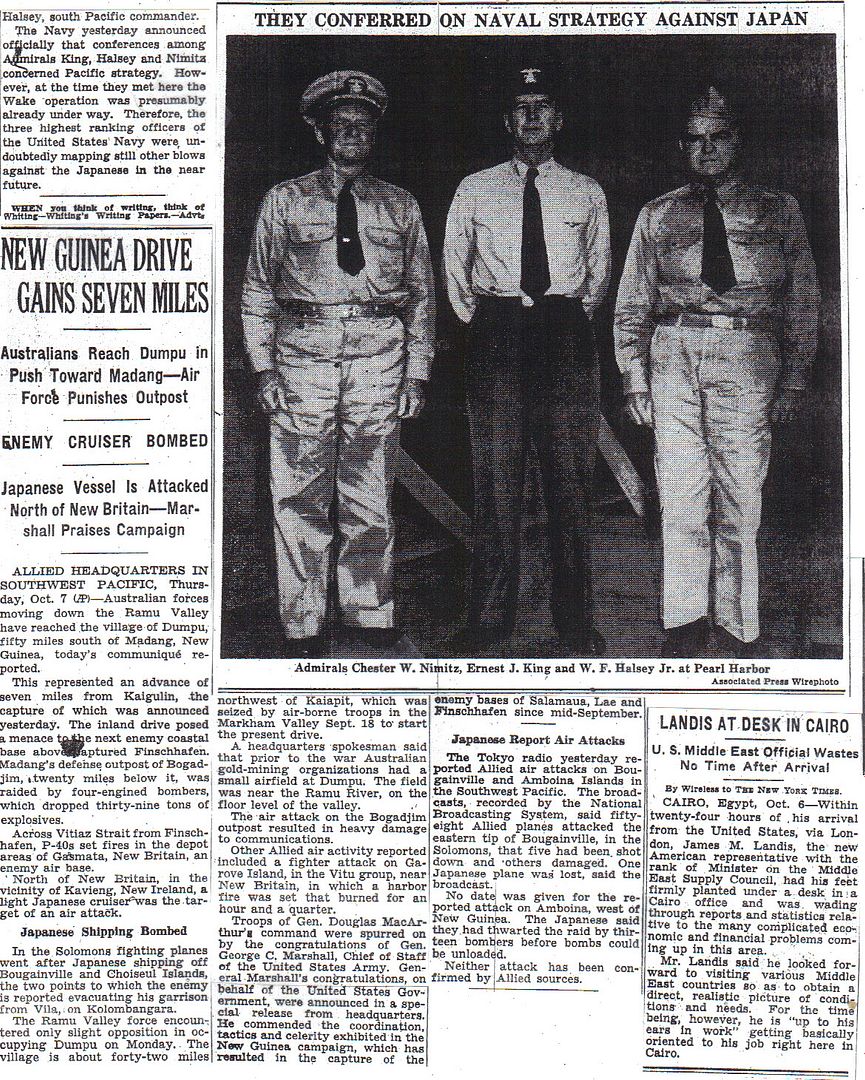
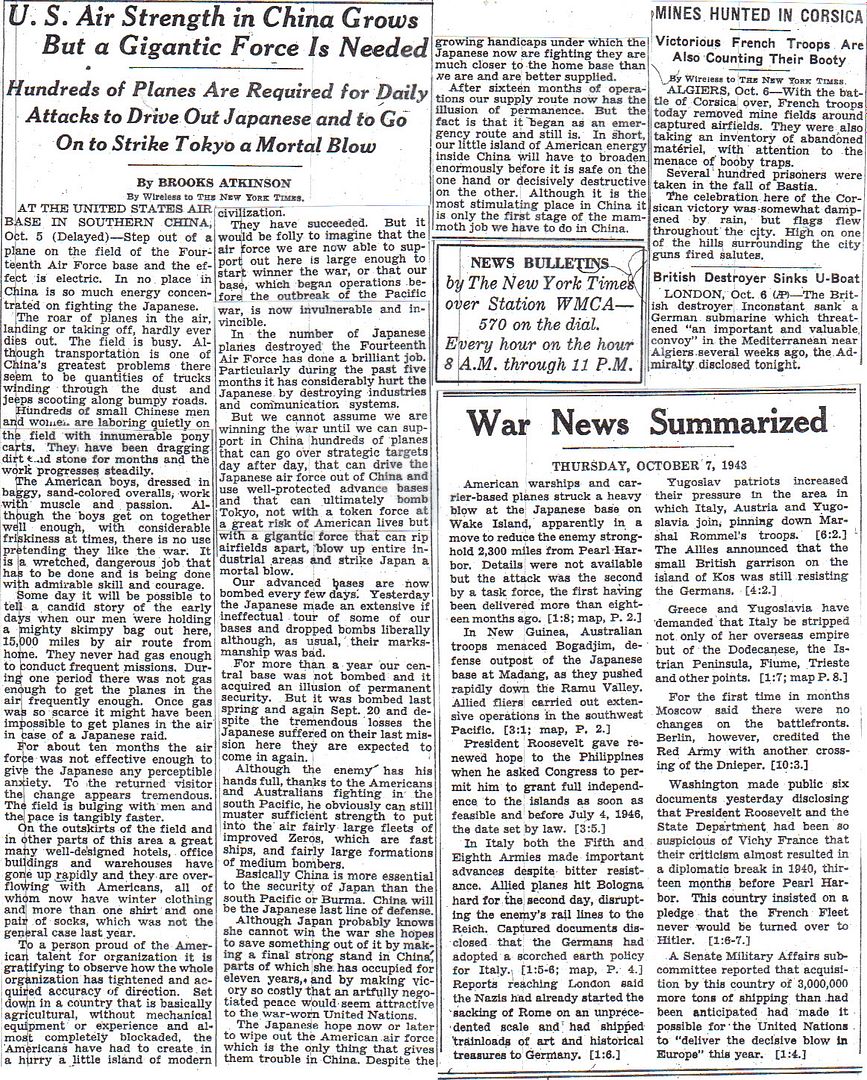

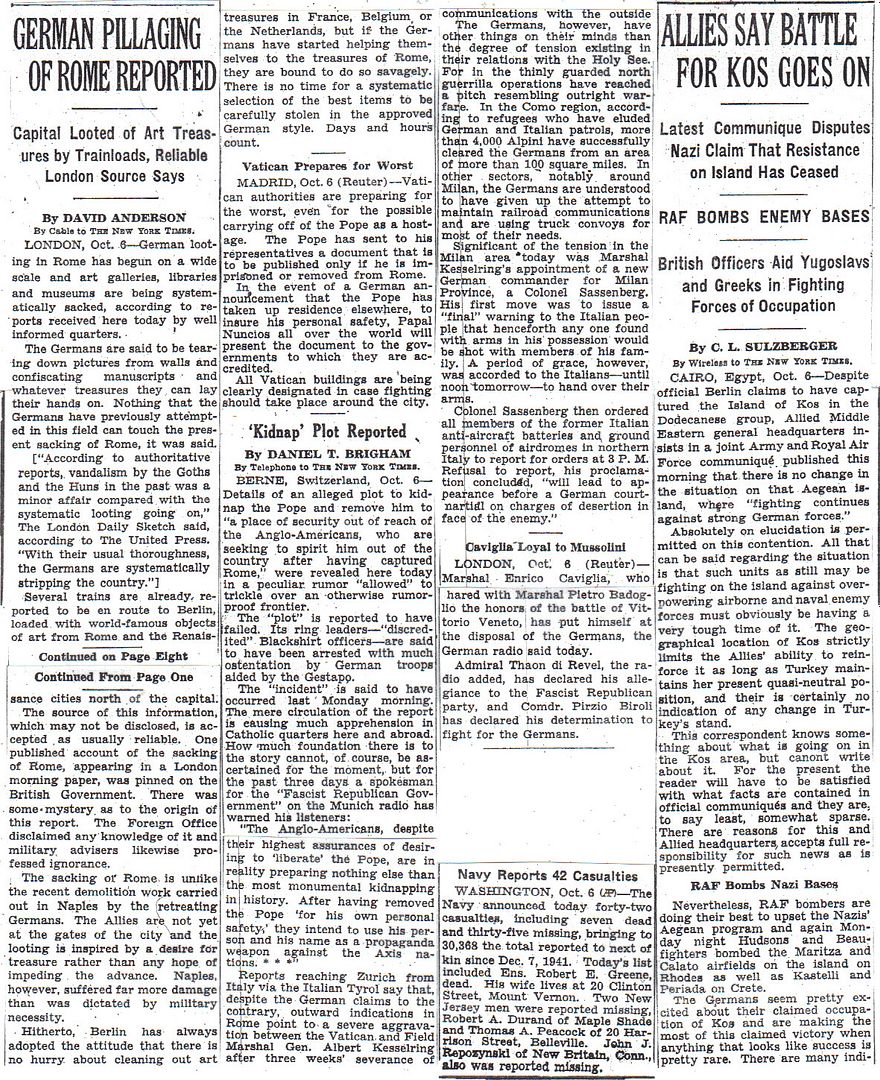
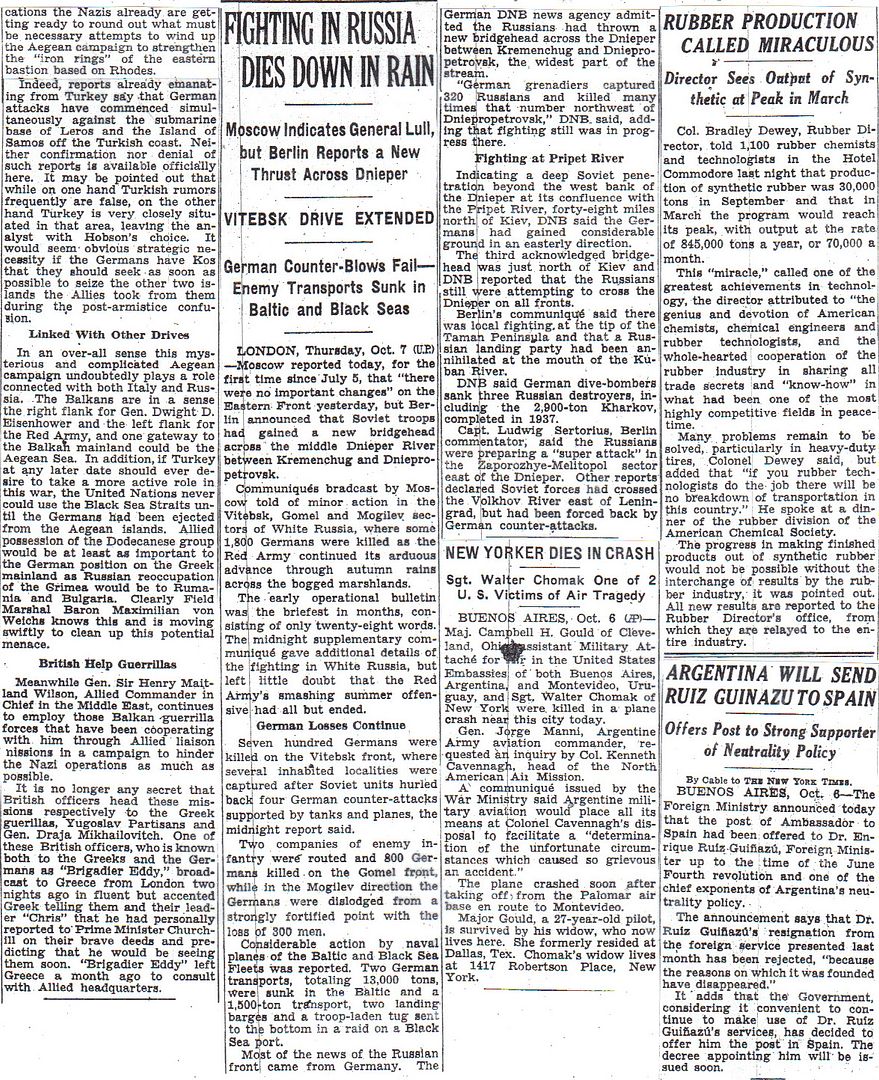
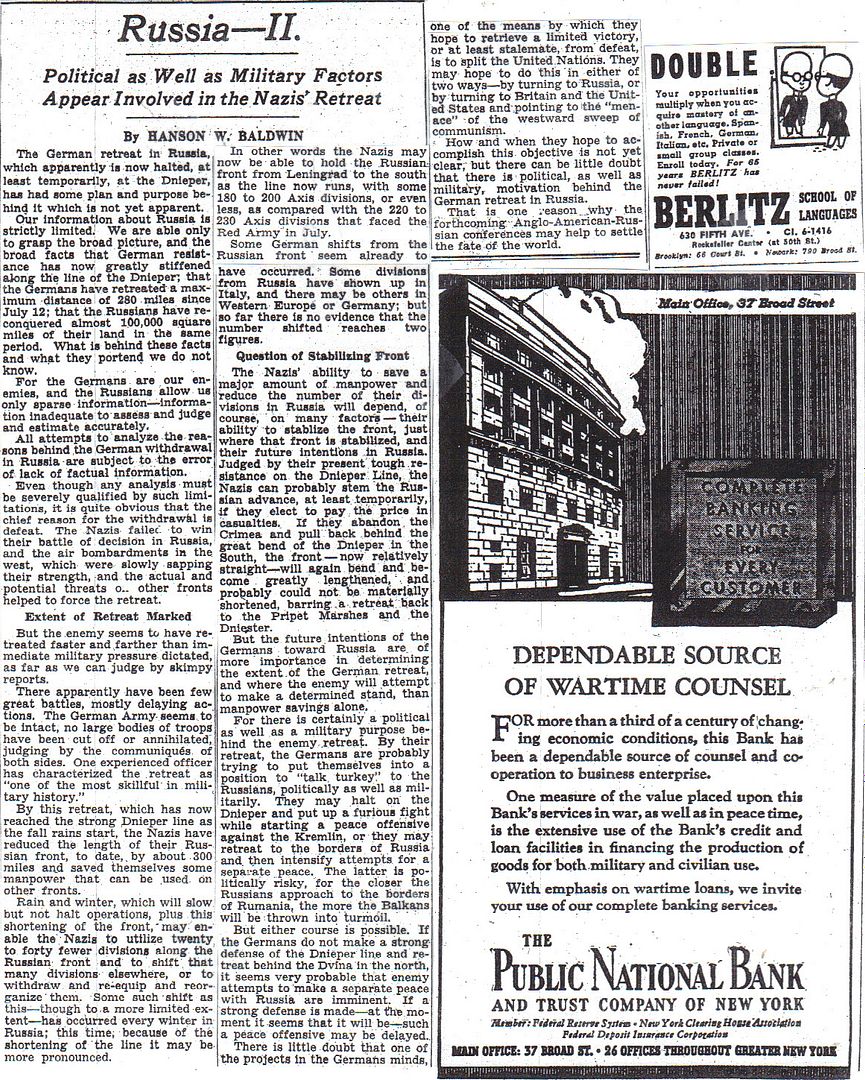
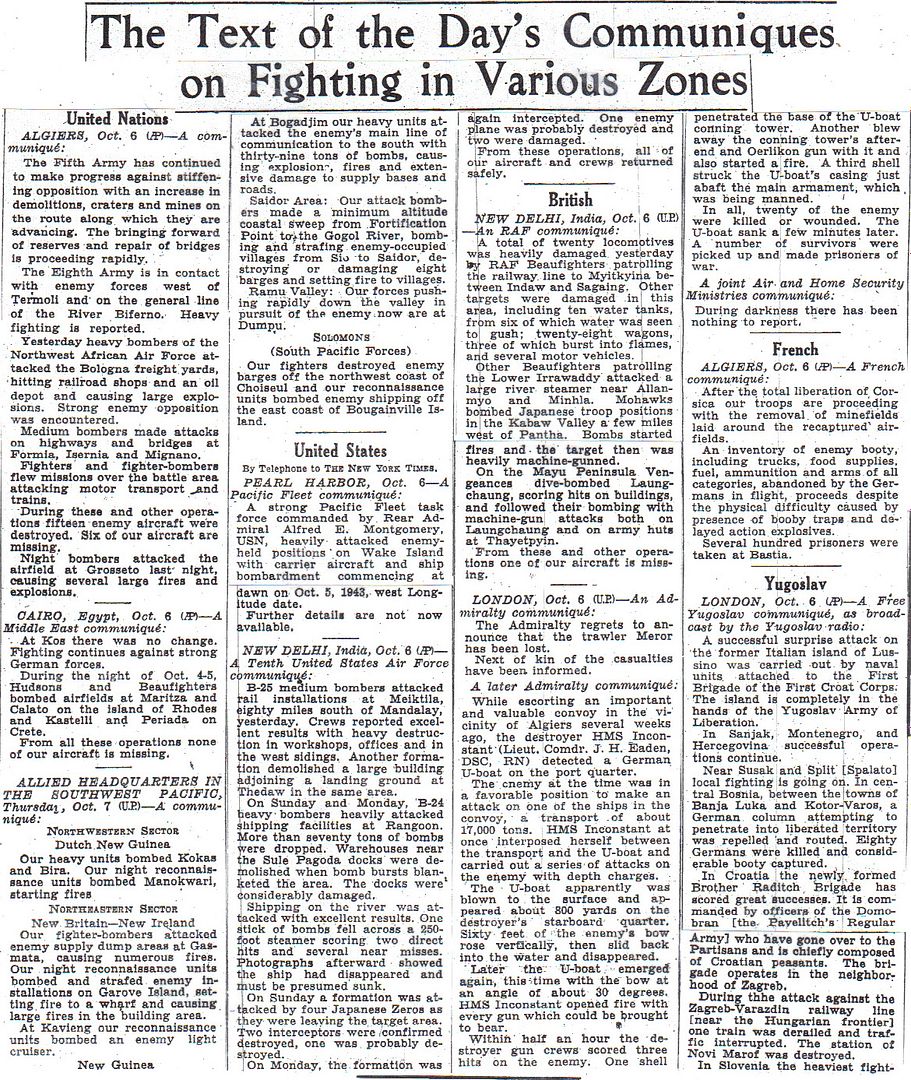
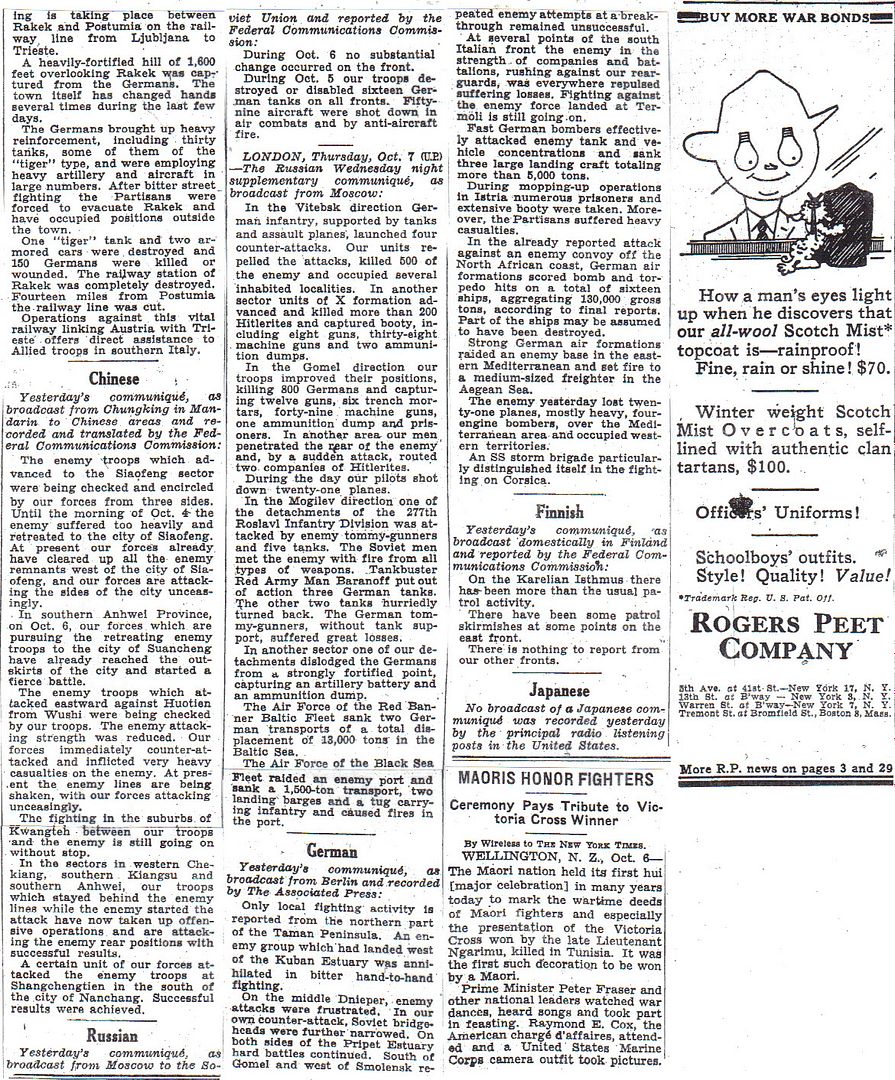
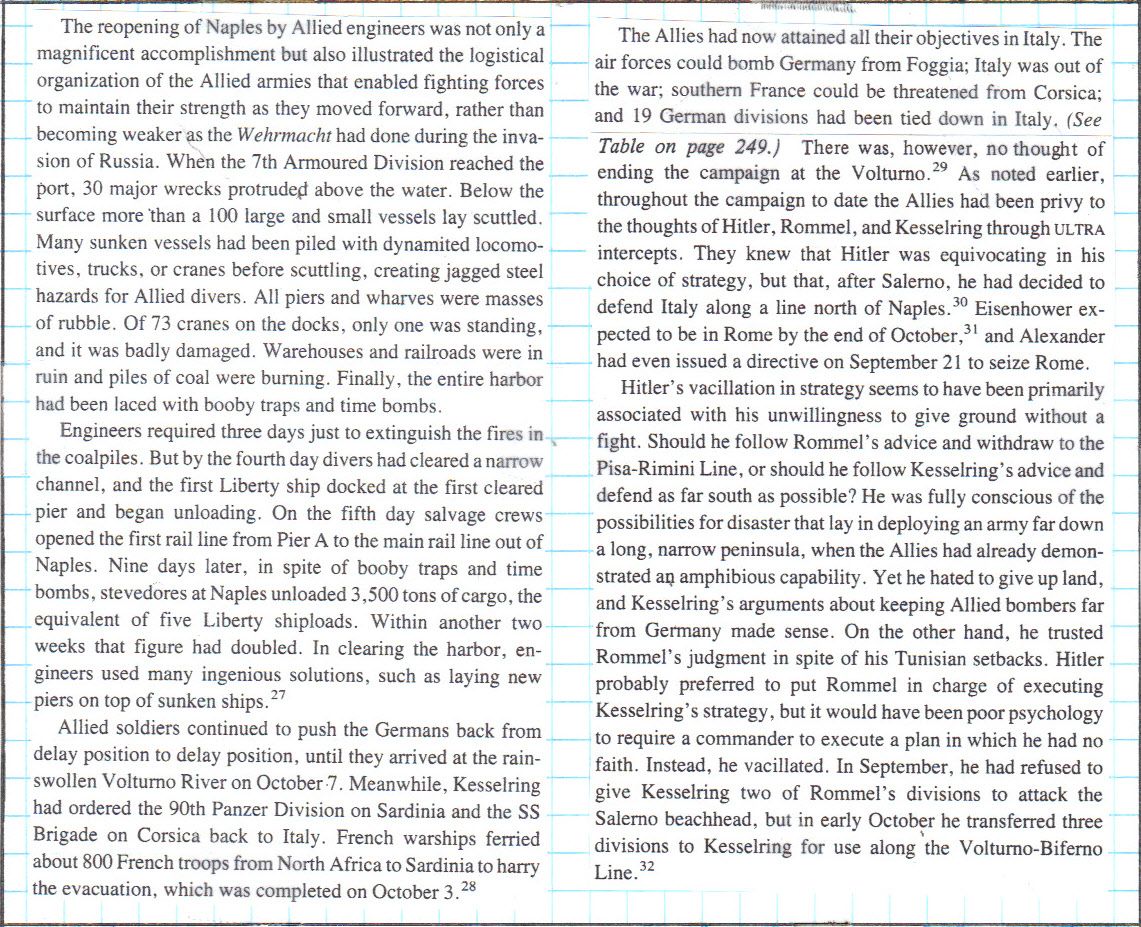
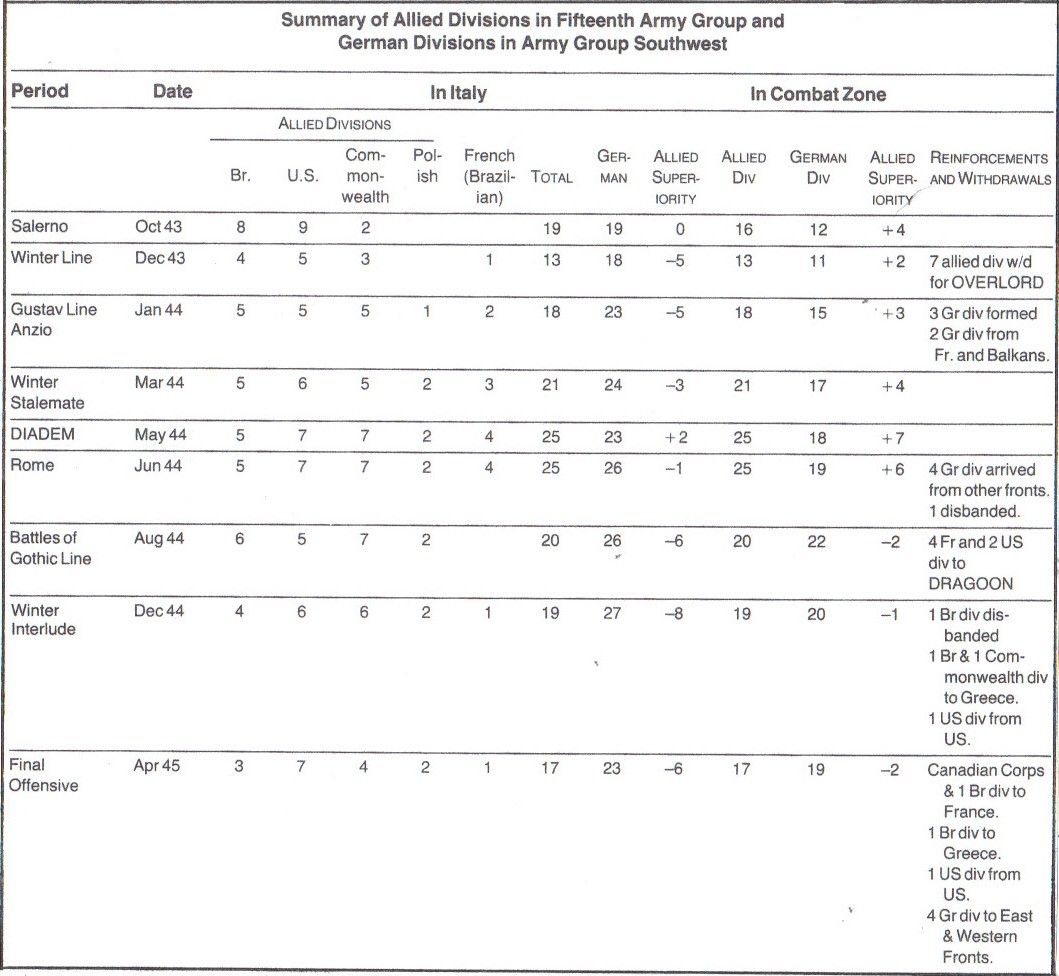
The West Point Military History Series, Thomas E. Griess, Editor, The Second World War: Europe and the Mediterranean
http://www.onwar.com/chrono/1943/oct1943/f07oct43.htm
Red Army builds up its Dniepr bridgeheads
Thursday, October 7, 1943 www.onwar.com
Soviet reinforcements crossing the Dniepr River [photo at link]
On the Eastern Front... Soviet forces launch a new offensive in the north, capturing Nevel. Along the Dniepr River, there is a lull in the fighting. Red Army forces are resupplying and reinforcing the bridgeheads gained in recent fighting. In the Caucasus, Soviet forces take Taman on the western end of the Kuban Peninsula.
In the Mediterranean... In the Aegean Sea, a British squadron of 2 cruisers and 2 destroyers intercept a German convoy bound for the island of Cos. Seven transports and one convoy escort are sunk.
In Italy... The German 16th Panzer Division breaks contact with the British 78th Division around Termoli and pulls back behind the Trigno River. British forces choose not to pursue.
http://www.etherit.co.uk/month/thismonth/07.htm
October 7th, 1943 (THURSDAY)
UNITED KINGDOM: England, the VIII Bomber Command flies Mission 110. During the night of 7/8 October, 4 B-17 Flying Fortresses drop 240,352 leaflets over Paris at 2257-2307 hours.
Frigate HMS Balfour is commissioned.
NETHERLANDS: Fifteen RAF Bomber Command aircraft lay mines in the Frisian Islands.
FRANCE: During the night of 7/8 October, four USAAF Eighth Air Force B-17 Flying Fortresses drop 240,352 leaflets over Paris at 2257-2307 hours. Meanwhile RAF Bomber Command lay mines off three U-boat bases in the Bay of Biscay: five lay mines off Brest, four off Lorient and three off St. Nazaire with the loss of one aircraft. In another mission, 13 RAF bombers drop leaflets over northern France.
GERMANY: An order is issued by the Luftwaffe for the establishment of a number of night ground-attack groups within the service. Thus a number of Störkampfstaffeln (Harassing Squadrons) already operating are put on a more organised footing. The main equipment of these units are the Arado 66 and Gotha 145 two seat trainers equipped to carry 2 and 4 kg anti-personnel bombs. (21)
During the night of 7/8 October, RAF Bomber Command sends 343 Lancasters to bomb Stuttgart; 314 actually bomb the target. The first aircraft to be equipped with ABC, (night-fighter communications jamming known by the crews as “Airborne Cigar”), from 101 Squadron is operated tonight. The German night-fighter controller is confused by the Mosquito diversion on Munich and only a few night fighters reach Stuttgart at the end of the attack; four Lancasters are lost, 1.2 per cent of the force. The target area is cloud-covered and the H2S radar Pathfinder marking developed in two areas. In another mission, 15 Lancasters carry out a diversionary raid without loss and claim hits on the Zeppelin factory at Friedrichshafen. Bomber Command Mosquitos are also active with ten bombing Munich, seven hitting Emden and five attacking Aachen.
U-248 and U-794 is launched.
U-350, U-862, U-998 and U-1193 are commissioned.
U.S.S.R.: Nevel, a rail center north of Vitebsk, and Taman fall to Soviet forces. A lull in fighting begins along the Dniepr River south of Kiev as the Soviet forces pause to bring up supplies and build bridges. German resistance is stiffening all along the line and the progress of Red Army is becoming less spectacular.
ITALY: The U.S. Fifth Army begins preparations for an assault across the Volturno River. The crossing date is set tentatively at the night of 9/10 October and later postponed to the night pf 12/13. The U.S. VI and British X Corps improve positions along the southern bank of the river. In the British Eighth Army’s XIII Corps area, another brigade of the 78th Division, the last to arrive in Italy, lands in the Biferno bridgehead as the Germans retire across Trigno River.
Bad weather cancels many operations. Northwest African Tactical Bomber Force medium and light bombers strike roads, railway, junction, and town areas in the Capua and Guglionesi regions while RAF Desert Air Force fighter-bombers hit trucks in the Termoli-Vasto areas.
German forces withdraw around Termoli and fall back behind the Trigno River. Montgomery does not follow closely.
GREECE: USAAF Twelfth Air Force B-24 Liberators attack two targets: 24 bomb Kastelli Airfield while 11 bomb Maritza Airfield on Rhodes.
MEDITERRANEAN SEA: A German convoy bound for Kos in the Aegean Sea is intercepted by 2 cruisers and 2 destroyers. The British Task Force sinks 7 transports and one destroyer.
Bad luck for U-81 in the Mediterranean. The boat attacked an Italian freighter with 6 torpedoes, but all missed. (Good luck for the Italian!)
CHINA: 4 Fourteenth Air Force B-25 Mitchells attack a 2,500-ton freighter 100 miles (160 km) S of Amoy, China scoring 3 direct hits; the vessel is left burning and listing.
FRENCH INDOCHINA: The Fourteenth Air Force dispatches 9 B-24s and 22 fighters to hit a cement plant at Haiphong causing heavy damage to the kiln building.
NEW GUINEA: In North East New Guinea, the Australian 2/17th Battalion continues battling the Japanese at Kumawa in the Finschhafen area.
PACIFIC OCEAN: Submarine USS R-44 sunk by the Japanese Shimushu class escort vessel Ishigaki. Two Survivors were picked up and ended up in captivity.
In the Formosa Strait, four USAAF Fourteenth Air Force B-25 Mitchells attack a 2,500-ton freighter 100 miles (160 km) south of Amoy, China scoring three direct hits; the vessel is left burning and listing.
SOLOMON ISLANDS: The Japanese complete evacuation of Vella Lavella Island.
BISMARCK ARCHIPELAGO: A Fifth Air Force B-24 on patrol bombs Umboi Island, scoring damaging hits on several buildings.
WAKE ISLAND IJN Rear Admiral Shigematsu Sakaibara, commander of the Japanese garrison on the island, orders the execution of 96 American civilian construction workers who have been held on the island since the American surrender in December 1941. The men are marched to the beach and machine gunned. This followed two days of attacks by a USN task force (see 5 October). I have heard two claims of why the men were executed, (1) the Japanese claimed the civilians were trying to make radio contact with the task force and (2) the Japanese were afraid that the U.S. was going to invade the island and the civilian prisoners would tell the invaders where the Japanese defensive positions were and how weak they were. After the war, the Sakaibara, and eleven of his officers, were sentenced to death by a US Naval Court at Kwajalein.
CANADA: Destroyer HMCS Cayuga laid down Halifax, Nova Scotia.
U.S.A.: Baseball!
The motion picture “Lassie Come Home” premieres at the Radio City Music Hall in New York City. Directed by Fred M. Wilcox, this canine adventure based on an Eric Knight book stars Lassie, Roddy McDowall, Donald Crisp, Dame May Whitty, Edmund Gwenn, Elsa Lanchester and Elizabeth Taylor. This is the first Lassie’s and Liz Taylor’s first movie.
Destroyer escorts USS Thornhill and USS Wingfield are laid down.
Destroyer escorts USS Edward H Allen & Tweedy launched.
ATLANTIC OCEAN: U-703 picked up three survivors from Hope Island in the Arctic Sea (Grid AC 12). The three people (two men and a woman) were the last survivors from the Soviet steamer Dekabrist, which had been sunk on 5 Nov 1942 by a JU-88 aircraft. The entire crew had escaped to this island. In May 1943 they were detected by an He-111 aircraft and on 24 July, 1943, U-354 picked up the ship’s master, leaving the remaining survivors behind but providing food and vitamin tablets. When U-703 reached the island in September, three of those stranded still lived. The U-boat crew enjoyed watching these people, with the help of lots of food and care, come slowly back to human civilization after living nearly a year on such an island.
It was really Taylor’s second film. Learn more in the review tomorrow.
The comparison of German/Allied division numbers can be misleading. The average German division at this time has only six infantry battalions, while the Allied counterpart has nine. The Germans had to strip three battalions from the standard table of organization because of the losses in Russia. So while an Allied division might have up to 15,000 men, the German counterpart would have less than 10,000. Most German divisions do not have their full complement of troops even at the six battalion organization table.
There was an article on synthetic rubber above. A little info below:
http://iisrp.com/WebPolymers/00Rubber_Intro.pdf
Synthetic Rubber The importance of the rubber industry ever since it first appeared and the decisive role that it has played in the development of modern civilization prompted much interest in discovering its chemical composition in order to synthesize this product. Through these research projects, the tire industry saw the possibility of breaking away from the grip of the world’s natural rubber plantations.
The drop in natural rubber production in Brazil coincided with World War I (1914-1918), triggering the need for lower-cost products with steadier supplies in order to manufacture tires. The pressures imposed by the conquest of the plantations of Asia by the Japanese prompted the development of a rubber that was able to meet the extraordinarily high demands of the troops at that time, although its structure differed somewhat from its natural counterpart.
This was how GR-S, Buna S, Hycar OS and SBR appeared, which are styrene and butadiene copolymers. The launch-pad for the massive development of the synthetic rubber industry, this product could be vulcanized easily, and became the flagship of the world rubber industry, although its properties did not correspond to all the qualities of natural rubber. But its costs and main characteristics made it into an unbeatable competitor. Although synthetic rubber had been known since 1875, its production had been expensive and almost negligible.
During World War II, a crucial historical episode altered the scenario for this market. On December 7, 1941, the USA entered the War. Three months after the attack on Pearl Harbor, the Japanese invaded Malaysia and the Dutch East Indies, desperate to take over natural rubber production from the allies. This gave the Axis control over 95% of world rubber supplies, plunging the USA into a crisis.
Each Sherman tank contained twenty tons of steel and half a ton of rubber. Each warship contained 20,000 rubber parts. Rubber was used to coat every centimeter of wire used in every factory, home, office and military facilities throughout the USA. There was no synthetic alternative. Looking at all the possible sources, at normal consumption levels, the nation had stocks for around one year. And these reserves also had to supply the largest and most critical industry in the history of the world during a time of rapid expansion: the arms segment.
The response of Washington was rapid and dramatic. Four days after Pearl Harbor, the use of rubber in any product that was not essential to the war drive was banned. The
5
speed limit on US highways fell to 35 miles an hour, in order to reduce wear and tear on tires countrywide. Rubber chips were sold a penny or more per pound weight at over 400,000 depots all over the country. Even President Franklin Roosevelt’s pet dog Fala saw his rubber toys melted. This was the largest recycling campaign ever recorded in history, ensuring the success of the Allies through to 1942.
Under these circumstances, an order was sent to all chemists and engineers to develop a synthetic rubber industry. In 1941, the total output of synthetic rubber barely topped 8,000 tons, consisting largely of products not suitable for tires.
The nation’s survival depended on its capacity to manufacture over 800,000 tons of products that had barely begun to be developed. There were few detailed instructions on how the factories should organize themselves to produce this vast amount. No facilities had been built, nor was there any way of producing enough raw materials to produce rubber.
The US industrial sector had never been called upon to shoulder such a massive task, achieving so much so quickly. The engineers were given just two years to reach this target. If the synthetic rubber program failed, the capacity of the USA to fight the war would be blunted. This US drive was to help spread synthetic rubber throughout the world’s market, even in Brazil as it strove to consolidate its industrial park during the post-War years.
http://www.americansyntheticrubberco.com/company-history
The Us Govt started the National Synthetic Rubber Corporation in 1943 and took over the 51 producing plants. It was sold to private industry in 1954.
I concluded that, contrary to much conservative opinion, the seeds of America's downfall were planted far earlier than the 60's. Very similar attitudes (minus the patchouli oil and firebombings) were prevalent during the so-called Greatest Generation, at least on the home front, and Roosevelt's Stalinist advisors in the 30's were the culprits. Winning the war bought us a respite and 20 years of economic prosperity, just as the election of Ronald Reagan did in 1980. But the overall trend toward Socialism eventually resumed.
There is some truth to what you say. Despite Stalin’s machinations in the Non-Aggression Pact to avoid it, the defeat of Hitler was accomplished at the cost of copious amounts of Russian blood. They took casualties that the Americans would never have accepted in fighting overseas. Of course, the Russians took most of those casualties in defense of their homeland, and their brutal regime didn’t care what it cost to win. The people dying had no say in the matter.
But yes, the entire American way of war is based on substituting firepower and production for combat deaths. You can look back as far as the Civil War to see it’s true; draft riots in New York, bounty men deserting at the first chance to enlist in a different state, etc.... That’s all part of our history.
Had Walter Cronkite been as senior and influential back then as he was in the 60's, they might have gotten their wish. Fortunately, the sacrifices the Marines made at Tarawa pissed off enough of the American public to re-invigorate the will to win that Pearl Harbor had initially ignited.
The Germans were also aware of it. But they didn’t count on the Russians being our blood proxies.
"Throughout Europe, in attics and basements, in secret cupboards so small they could barely crouch, Jews struggled to hide themselves from their Nazi persecutors.
Sometimes they were hidden by gentile friends; sometimes by complete strangers.
"In Amsterdam, the Frank family, along with several others, hid for months in a secret annex, supplied with the essentials of life by Miep Gies.
Dutch woman Dieuwke Hofstede (pictured) opened her doors to Henny Kalkstein (right).
Convents and monasteries also hid Jewish children.
In the northern Italian town of Assisi, Father Rufino Niccacci supplied Jews with forged identity papers and helped them to find homes and work.
In France, the entire village of Le Chambon-sur-Lignon, guided by its pastor, André Trocmé, was committed to hiding/protecting Jewish refugees.
"In Eastern Europe, finding a hiding place was extremely difficult.
Although many Poles were antisemitic and many others feared the consequences of aiding Jews, some Poles responded to the cries for help.
Irene Gut Opdyke hid 12 Jews in the house of a German officer for whom she worked as a housekeeper.
In Wlodawa, Poland, a Jewish man named Yankel lived for a year in a hole in the floor of a barn.
The farm itself was occupied by German soldiers."
"When the war turned against the Germans, they began a concerted effort to conceal their crimes.
Hence, Sonderkommandos, most of them Jews, were ordered to begin the grisly task of exhuming the bodies of Nazi Germany's millions of victims and disposing of the remains.
This photograph shows a bone-crushing machine that was used to grind up the body parts that could not be burned.
The man on the right, with the surname of Korn, burned about 46,000 corpses, including that of his wife, during the three months he worked as a Sonderkommando."
The sailor to infantry KIA ratio in Guadalcanal operations was over three to one.
Sent north to the Aleutians, they made radar contact with what they thought was a lone freighter. In fact this was the refrigerator ship Koko Maru escorted by the kaibokan (ASW frigate) Ishigaki. When S-44 attempted to attack on the surface, she was quickly overwhelmed by the Ishigaki.
The frigate's first shell struck the sub's conning tower, preventing her from diving, and her powerful spotlights prevented the sub's gun crews from being able to see their target. Several more rounds struck the sub, knocking out its guns and causing severe flooding. A white bed sheet was raised to indicate they surrendered, but the Ishigaki continued to attack. About eight of the fifty-seven officers and men managed to get off before the sub sank, but only two were picked up.
Disclaimer: Opinions posted on Free Republic are those of the individual posters and do not necessarily represent the opinion of Free Republic or its management. All materials posted herein are protected by copyright law and the exemption for fair use of copyrighted works.